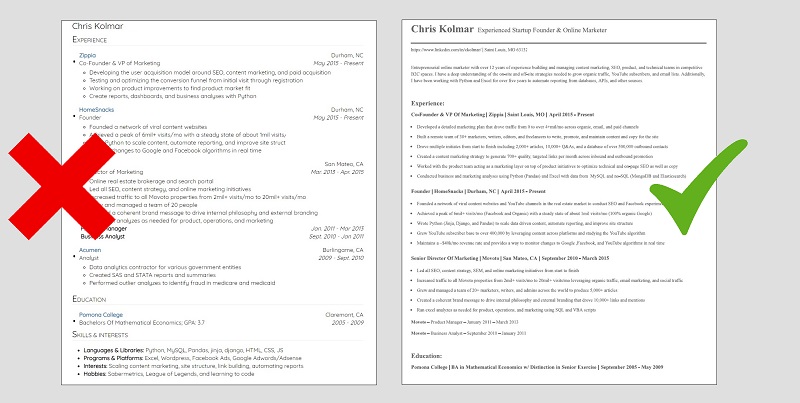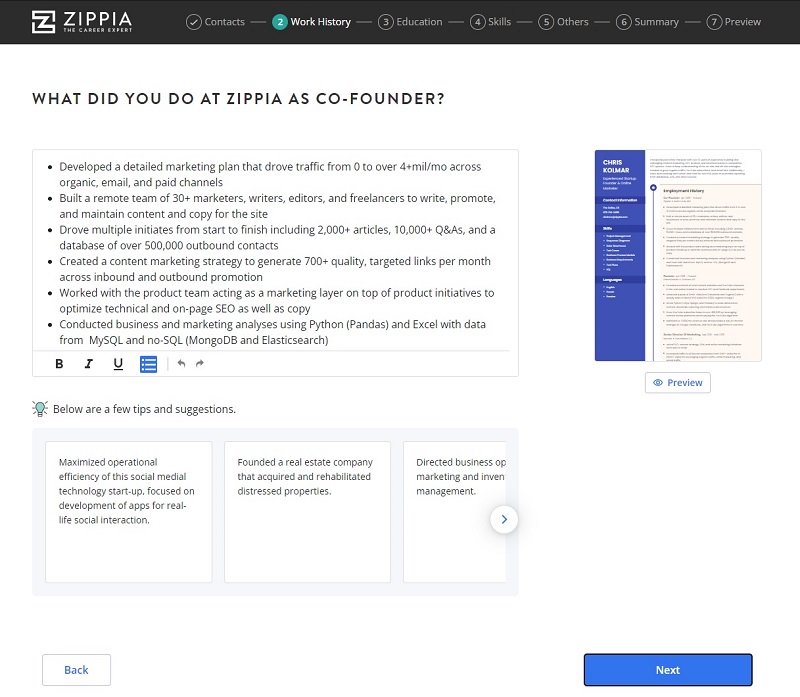- Parts Of A Resume
- How To Write A Resume
- Resume Skills Section
- Resume Objective Section
- Career Objective Section
- Resume Reference Section
- Resume Summary Section
- Resume Summary Example
- Resume Interests Section
- Address On Resume
- Relevant Work Experience
- Anticipated Graduation Date On Resume
- Education Section On Resume
- Contact Information On Resume
- Statement Of Qualifications
- How To List Publications On Resume
- Accomplishments On Resumes
- Awards On Resume
- Dean's List On Resume
- Study Abroad On Resume
- Resume Format
- Resume Templates
- General Resume Examples
- Resume Builder
- Resume Format
- Resume Margins
- Resume Header
- Work Experience On Resume
- Irrelevant Work Experience
- Listing Languages On Resume
- Volunteer Work On Resume
- GPA On Resume
- Resume Title
- Summary Of Qualifications
- Resume Picture
- Python Project On Resume
- Google Docs Resume Template
- Professional Bio On Resume
- Multiple Positions At Same Company
- Relevant Coursework Resume
- Where And How To Put Internships On Your Resume
- Professional Resume Formats
- Resume Types
- What Is an Infographic Resume?
- Why Do I Need an Infographic Resume?
- Update Your Resume Now To Get Your Next Job Faster
- How Can an Infographic Resume Help Me?
- How to Make an Infographic Resume
- What to Include in an Infographic Resume
- Tips for Creating an Infographic Resume
- Sign Up For More Advice and Jobs
The current job market is flooded with people who submit their resumes in the hopes that a hiring manager will notice it. With the number of applicants that popular position openings see, getting lost in the shuffle can seem more likely than not.
A tactic that many job seekers looking to set themselves apart from the competition will use is developing an infographic resume.
Want to save time and have your resume ready in 5 minutes? Try our resume builder. It’s fast and easy to use. Plus, you’ll get ready-made content to add with one click. See 10+ resume templates and create your resume here.

One of users, Diana, had this to say:
I was guided on how to make a detailed and professional resume on Zippia. I was able to download it with unlimited access to all features.
What Is an Infographic Resume?
An infographic resume is a creative resume that relies on visual marketing tactics to make themselves distinct from the myriad of traditional text resumes a company will come across when hiring. Instead of just writing out lists of your personality, accomplishments, and professional history, an infographic resume uses visual elements to communicate these things.
The graphics featured in this formatting aren’t just cute pictures to grab attention on your resume. They should follow the definition of its name and visually convey important information in a way that’s easy to follow. If a potential employer feels like they’re just looking at pictures when they see your resume, your infographics are not doing their job.
The stylistic openness that focusing on infographics provides usually creates a unique resume that’s interesting to look at and read. This can be useful for making yourself stand out among other applicants for the design and layout of your infographic resume.
Why Do I Need an Infographic Resume?
Nobody technically needs to use an infographic resume in the place of a traditional text-based one unless a job listing specifically requests it. In fact, it may not be recommended to use it when you’re not familiar with implementing graphics into a resume document. It’s also possible that an infographic resume won’t make it past an Applicant Tracking System (ATS) because it relies on images more than keywords.
The risk of sending an infographic resume in for a job opening you’re hoping to land is that it will either dazzle the hiring manager or fall flat. There’s rarely middle ground when it comes to formatting your resume like this because it’s a dramatic approach. To avoid these challenges, always keep a copy of your traditional resume that outlines the same information and send them together when possible.
Update Your Resume Now To Get Your Next Job Faster

How Can an Infographic Resume Help Me?
Although there may be some considerations to make before deciding to create an infographic resume, it can also greatly help in your job search if it’s executed well.
The following are ways that using an infographic resume as opposed to a traditional one can help you.
-
Makes your resume unique. When you’re the designer behind your own infographic resume, it’s a likely bet that nobody else will have a resume like yours. This can be helpful when applying for a competitive position because it makes you stand out from other candidates.
-
Demonstrates your creativity. Unlike a traditional resume format, infographics let a candidate embrace their creativity when creating their resume. Whether or not you work in a creative industry, such as graphic design, employers seek out applicants who demonstrate creativity. Creative employees can inspire innovation within their company and implies strong strategic thinking skills.
-
Embellishes your professional story. A resume is meant to give a small window into who a job applicant is, what they’ve done, and what they will probably be like as an employee. While a traditional text resume can accomplish this task, it won’t be nearly as impressive as including visuals to describe your story.
Using an infographic resume can get a hiring manager more invested in your professional story because it’s more than words on a page.
How to Make an Infographic Resume
Creating a successful infographic resume depends on your visualization and design skills. An individual whose skill levels are in the beginner stages will have to take a more simplistic approach than a graphics expert.
For the average Joe of graphics or image-making knowledge, start with browsing templates for infographic resumes. Many sites can provide you templates for resume designs that are similar to infographics, but these won’t be exact.
Examples of websites that have infographic resume templates include:
If a company you’re applying to specifically requests an infographic resume, it’s recommended to use more details, charts, and graphs. Using only basic graphics or bright colors to make your resume have a more infographic style won’t fly if the employer is expecting more.
Then again, there’s one more thing you can do.
Make a new resume and get more interviews.
Plus, a great resume will give you an advantage over other candidates. You can write it in our resume builder here. Here’s what it may look like:
What to Include in an Infographic Resume
Even if you’re working from an infographic resume template, there are some things that you still are responsible for including.
-
Organization and structure. Using an infographic template doesn’t excuse you from considering the organization and structure of your resume. Being able to easily read through and understand your resume’s different parts is crucial to its success. Eye-catching visuals won’t make up for disorganization.
-
Your experience and skills. The structure of an infographic resume may differ from a traditional one, but you still need to cover the same basic information. Make sure that you don’t neglect to include information about your experience and professional strengths in the pursuit of creating impactful graphics and charts. A resume needs to show a hiring manager more about you and not just how catchy your resume’s visuals are.
-
Contact information. Similar to how your resume still needs to include the necessary information of your experience and skills, you should also make sure to provide contact information. The contact info on your resume should be bold and clear to the reader. If a hiring manager is captured by everything else they’ve seen about your abilities but cannot find your contact information anywhere, you probably won’t receive a call for an interview.
-
Clarity. A lot of candidates who choose to craft an infographic resume may run into the issue of having an unclear message. An infographic resume needs clarity. Without being straightforward with the information you’re trying to get across, your resume might as well be a random collection of images. The last thing you want is for a potential employer to look at your resume and feel confused.
-
Engaging visual design. It’s not really an infographic resume unless you’re presenting some form of engaging visual design. In this style of resume, you’re reaching out to the receiver through images, charts, and layouts. Sometimes, simply putting together images and visually appealing patterns can be enough to pull the hiring manager into being attentive to your story.
To make your imagery even more engaging, you can use numbers in your graphics, add humorous elements, or implement icons to represent ideas.
Tips for Creating an Infographic Resume
-
Keep it professional. While opting for an infographic resume does award you more creative freedoms, you should still maintain a tone of professionalism. Try to avoid images that give off a childish or immature appearance.
It will distract from your message. You can have fun with the design of your resume, but don’t lose sight of the fact that it’s the document that decides if you’ll land your next job.
-
Don’t include distracting elements. You want to draw attention with an infographic resume, but you don’t want to distract the reader from the takeaway that you have the skills and background for the job. Including extremely bright colors and overpowering graphics won’t help get a hiring manager interested in hiring you because they won’t be able to get to the depth of your resume.
-
Use infographics to tell a story. Your resume is supposed to give potential employers a concise picture of who you are as an employee. With an infographic resume, you can use creative outlines to tell a more defined story with your resume. Implement your graphics to coincide with your professional history and skills to paint you as the most promising candidate.
This can be done in a couple of ways, one of the most popular beings to illustrate a timeline. Developing a graphic for the timeline of your career is an excellent way to explain your background and accomplishments to an employer interestingly and understandably.
-
Focus on simplicity. It can be tempting to go crazy on flashiness and fun visuals when designing an infographic resume. You’re trying to create visual appeal in your resume’s information, but you don’t want the message to get overshadowed. Stick to simplistic styles when you’re thinking about how you want your infographic resume to turn out.
-
Consult a professional if you’re a beginner. You’re the best person possible to accomplish the work you do, and there’s someone out there who can create the best possible resume for you. If you’re a design beginner who’s getting overwhelmed with hearing everything that goes into an infographic resume, don’t worry. There’s always the alternative of hiring a professional resume writer who specializes in infographics.
Sometimes hiring outside help can make the difference between being offered your next position or being forgotten. Consider turning to someone with expert graphic and resume-building skills to help you in this area.
Websites where you can hire resume builders include:
- Parts Of A Resume
- How To Write A Resume
- Resume Skills Section
- Resume Objective Section
- Career Objective Section
- Resume Reference Section
- Resume Summary Section
- Resume Summary Example
- Resume Interests Section
- Address On Resume
- Relevant Work Experience
- Anticipated Graduation Date On Resume
- Education Section On Resume
- Contact Information On Resume
- Statement Of Qualifications
- How To List Publications On Resume
- Accomplishments On Resumes
- Awards On Resume
- Dean's List On Resume
- Study Abroad On Resume
- Resume Format
- Resume Templates
- General Resume Examples
- Resume Builder
- Resume Format
- Resume Margins
- Resume Header
- Work Experience On Resume
- Irrelevant Work Experience
- Listing Languages On Resume
- Volunteer Work On Resume
- GPA On Resume
- Resume Title
- Summary Of Qualifications
- Resume Picture
- Python Project On Resume
- Google Docs Resume Template
- Professional Bio On Resume
- Multiple Positions At Same Company
- Relevant Coursework Resume
- Where And How To Put Internships On Your Resume
- Professional Resume Formats
- Resume Types





